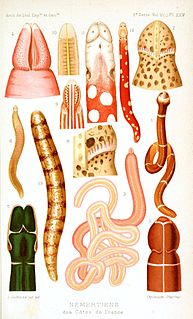
Nemertea is a phylum of animals also known as ribbon worms or proboscis worms. Most ribbon worms are very slim, usually only a few millimeters wide, although a few have relatively short but wide bodies. Many have patterns of yellow, orange, red and green coloration. The foregut, stomach and intestine run a little below the midline of the body, the anus is at the tip of the tail, and the mouth is under the front. A little above the gut is the rhynchocoel, a cavity which mostly runs above the midline and ends a little short of the rear of the body. All species have a proboscis which lies in the rhynchocoel when inactive but everts to emerge just above the mouth to capture the animal's prey with venom. A highly extensible muscle in the back of the rhynchocoel pulls the proboscis in when an attack ends. A few species with stubby bodies filter feed and have suckers at the front and back ends, with which they attach to a host.

The peninsular rock agama or South Indian rock agama is a common species of agama found on rocky hills in south India. An allied species, Psammophilus blanfordanus, is found in the Eastern Ghats, but north of the range of this species.

Causus is a genus of venomous vipers found only in sub-Saharan Africa. It is a group considered to be among the most primitive members of the family Viperidae based on head scalation, oviparity, venom apparatus, and because they have round pupils. However, this is contradicted by recent molecular studies. Seven species are currently recognized. They are commonly known as night adders.
This glossary of ichthyology is a list of definitions of terms and concepts used in ichthyology, the study of fishes.

Lophius americanus is a goosefish in the family Lophiidae, also called all-mouth, American anglerfish, bellows-fish, devil-fish, headfish, molligut, satchel-mouth, or wide-gape. It is native to the eastern coast of North America.
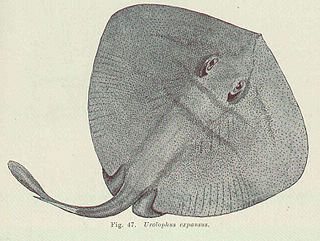
The wide stingaree is a little-known species of stingray in the family Urolophidae, found off southwestern Australia. It typically occurs over sand in water 200–300 m (660–980 ft) deep around the edge of the continental shelf. This species has a broad diamond-shaped pectoral fin disc, a slightly pointed snout, and a tail with a leaf-like caudal fin, skin folds along either side, and no dorsal fins. Between its nostrils is a skirt-shaped curtain of skin. It is grayish green above, with faint bluish lines beside and behind the eyes. The maximum length on record is 52 cm (20 in).

The spotted stingaree is an uncommon species of stingray in the family Urolophidae, endemic to shallow waters along the coast of southern Australia. It favors rocky reefs and seagrass beds. This species can be readily identified by its nearly circular, dark-colored pectoral fin disc, adorned with a complex pattern of white or cream spots. Its eastern and western forms differ slightly in coloration and have been regarded as separate species. There is a skirt-shaped curtain of skin between its nostrils. Its tail is fairly thick and terminates in a short leaf-shaped caudal fin; a relatively large dorsal fin is present just in front of the stinging spine.
The lobed stingaree is a common species of stingray in the family Urolophidae, endemic to southern Western Australia in shallow, inshore sand and seagrass habitats. This species is plain sandy in color above and has a broad, rounded pectoral fin disc. It is characterized by an enlarged, semicircular skin lobe of unknown function on the inner rim of each nostril. Its tail is slender, with lateral skin folds and a lance-like caudal fin but no dorsal fin. The maximum recorded width is 27 cm (11 in).

Seashore wildlife habitats exist from the Tropics to the Arctic and Antarctic. Seashores and beaches provide varied habitats in different parts of the world, and even within the same beach. Phytoplankton is at the bottom of some food chains, while zooplankton and other organisms eat phytoplankton. Kelp is also autotrophic and at the bottom of many food chains. Coastal areas are stressed through rapid changes, for example due to tides.
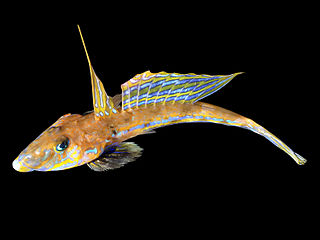
The common dragonet is a species of dragonet which is widely distributed in the eastern North Atlantic where it is common near Europe from Norway and Iceland southwards. It is a demersal species that occurs over sand bottoms. It lives to a maximum age of around seven years. It is caught in bycatch by fisheries and is used in the aquarium trade.

Cydippida is an order of comb jellies. They are distinguished from other comb jellies by their spherical or oval bodies, and the fact their tentacles are branched, and can be retracted into pouches on either side of the pharynx. The order is not monophyletic, that is, more than one common ancestor is believed to exist.

The blind electric ray is a little-known species of sleeper ray in the family Narkidae, endemic to New Zealand. It is found on the bottom, typically at a depth of 300–400 m (980–1,310 ft). Reaching 38 cm (15 in) in length, this species has a thin, nearly circular pectoral fin disc without visible eyes, and a short tail with a single dorsal fin. Its pelvic fins are divided in two, with the anterior portion forming a limb-like appendage; in males the claspers do not extend past the disc margin. A weak swimmer, the blind electric ray likely pushes itself along using its pelvic fins. It is known to feed on polychaete worms, and can defend itself with an electric shock. Reproduction is aplacental viviparous. The International Union for Conservation of Nature (IUCN) does not have enough information to assess the conservation status of this species.
Blennioclinus brachycephalus, the Lace klipfish, is a species of clinid found in subtropical waters of the Atlantic Ocean around South Africa. This species can reach a maximum length of 15 centimetres (5.9 in) TL. This species primarily preys on benthic fauna including isopods, amphipods, and mollusks.
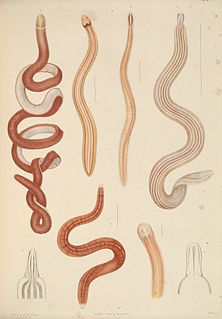
Emplectonema neesii is a species of ribbon worm in the phylum Nemertea. It is found on the middle and lower regions of the shore, under stones and in shingle and is common round the coasts of Britain and Ireland.

Ogcocephalus radiatus or the polka-dot batfish is an arrow-shaped fish in the family Ogcocephalidae with an elongated thin tail. It is dorso-ventrally flattened with round pectoral fins that sit flat on the bottom of the sea floor. It uses its pectoral fins and pelvic fins to "walk" along the bottom in a side-to-side shuffling motion.

Tubulanus polymorphus is a species of ribbon worm in the phylum Nemertea. It is found in the northern Atlantic Ocean and the northern Pacific Ocean. It occurs on the lower shore down to about 50 m (160 ft), on sand or gravel, under stones and among seaweed.

Tubulanus superbus, commonly known as the football jersey worm, is a species of ribbon worm in the phylum Nemertea. Found in the northern Atlantic Ocean, the North Sea and the Mediterranean Sea, it occurs from the lower shore down to about 80 m (260 ft), on sand or gravel.

Cerebratulus lacteus, the milky nemertean or milky ribbon worm, is a proboscis worm in the family Lineidae. This ribbon worm has a wide geographical range on both sides of the northern Atlantic Ocean.
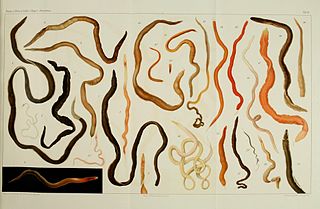
Cerebratulus marginatus is a proboscis worm in the family Lineidae. This ribbon worm has an Arctic distribution, and in the North Atlantic Ocean ranges as far south as Cape Cod and the Mediterranean Sea while in the Pacific Ocean it extends southwards to California.

















